Lose Weight
![]() Balanced Healthy Diet
Balanced Healthy Diet
Balanced Healthy Diet Guide
What is a balanced healthy diet? Eating a healthy balanced diet plan made easy, healthy food tips, balanced weight loss diet
What is a balanced diet? The key to eating a balanced healthy diet is getting the balance right, which means eating a wide range of foods from different food groups in the right proportions and the right amounts for your activity levels to sustain good health. We all need carbohydrates, proteins and fats to get all the nutrients we need to maintain a healthy body.
Over 20 years ago the USDA created the Food Guide Pyramid, – a food pyramid diagram showing the elements of a balanced healthy diet, which was followed by the MyPyramid icon in 2005, and in 2011 their latest creation, MyPlate.
The USDA MyPlate illustration below shows what proportion of foods should come from each food group. Think of it as a prototype of your usual meal. Fruits and vegetables should fill half of your plate, while proteins and grains get ¼ of the plate. Just off to the side is a white circle, which represents dairy products (milk, yogurt, cheese).
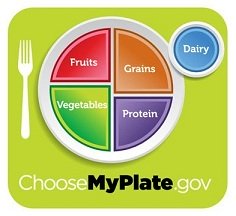
The Harvard TH Chan School of Public Health, part of Harvard University, published in September 2016, the 'Kid's Healthy Eating Plate', which follows a similar formula. It is based on healthy choices and presentation. The article provides lots of great tips and pictures. You can access it here.
Balanced Healthy Diet Simplified
Stay Active: The foundation of a balanced healthy diet is daily exercise and weight management, so stay active controlling your weight with a regular exercise routine and eat modest portions to meet your daily calorie needs.
Make a healthy food choice for your balanced plate when selecting a variety of foods from the following food groups:
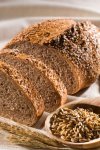
|
Whole Grains: Whole grains such as whole wheat bread, brown rice, oatmeal, etc. are the best source of carbohydrates, which our body needs for energy. The body digests whole grains much slower than it can with finely ground grains such as white flour. A slow digestion rate keeps the blood glucose (sugar) and insulin levels even, which not only controls the appetite but also prevents the development of heart disease and type 2 diabetes. The less processed the whole grains the better. |

|
Healthy Fats and Oils: Healthy fats should make up 1/3 of your daily calories intake. Food sources of healthy unsaturated fats are olive, corn, soy, peanut, sunflower, and other vegetable oils; avocado, nuts and seeds; and fatty fish which is a rich source of omega 3 fatty acids. Healthy fats eaten in place of highly processed carbohydrates will improve your cholesterol levels. Omega 3 fatty oils can protect you from heart disease. Limit saturated fats such as butter and avoid trans fats. |
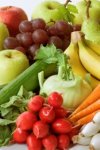
|
Fruits and Vegetables: Half of your plate should consist of fruits and vegetables. Go for color and variety - dark green, orange, yellow and red. A diet rich in high fiber fruits and vegetables decreases the risk of heart attack or stroke, lowers blood pressure; helps to avoid constipation and diverticulitis; protects from cataracts, macular degeneration and some types of cancer. Potatoes and French fries do not count as vegetables, as they are full of rapidly digested starch that affects blood sugar as much as refined grains and sweets. |
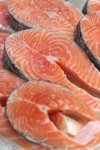
|
Healthy Proteins: Fill 1/4 of your plate with protein. Choose healthy proteins such as fish, skinless chicken, turkey, beans, and nuts. Eating beans and nuts in place of red or processed meat lowers the risk of developing diabetes and heart disease. Fish is a rich source of heart healthy omega 3 fats. Skinless chicken and turkey are low in saturated fat. Eggs are not as bad as some people think, and are a good choice for breakfast. Limit your egg intake to no more than 3 per week if you have diabetes or heart disease. |
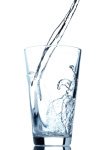
|
Drink Water, Tea or Coffee: You can complete your meal with a glass of water, a cup of tea or coffee. The Institute of Medicine set a general guide for an adequate water consumption of 125 oz. (15 cups) for men and 91 oz. for women (11 cups) per day. In most people 80% of this intake comes from beverages and 20% from food. The famous advice to drink 8 glasses of water daily has no evidence to support it, but is an excellent way to stay hydrated. Avoid sugary drinks and limit juice to a small glass per day. |
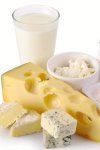
|
Dairy Products or Calcium and Vitamin D: Milk and dairy products should be eaten in moderation, as they are high in saturated fat. But also dairy products have been a traditional source of calcium which is essential for healthy teeth and bones. If you like dairy, stick to 1 to 2 servings per day, also take multivitamins and vitamin D supplements to improve calcium absorption. Choose fat free, low and reduced fat versions. If you don’t like dairy, take calcium and vitamin D supplements. |
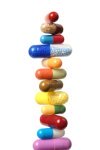
|
Multivitamins with Extra Vitamin D: Multivitamins cannot make up for unhealthy eating or replace healthy eating, but they can fill any nutrient gaps which you may have in your balanced healthy diet. Your vitamins should meet the requirements laid out by each individual country. For example, in the USA, it is the USP (U.S. Pharmacopeia) that’s sets the recommended amounts. Try to get at least 800 to 1000 IU of vitamin D daily. It is a good idea to discuss supplements with your doctor. |
Limit the Following Foods:
Red and Processed Meats: Red meat should be limited to no more than twice a week, as they are high in saturated fats. Avoid processed meats: deli meats, hot dog, and bacon as they are high in sodium. High consumption of red and processed meats is linked to diabetes, heart disease and colon cancer. Switch to a healthier protein choices such as fish, beans, chicken and nuts.
White Bread, Pasta, Rice, Potatoes, Sugary Drinks and Sweets: Potatoes, white bread, white pasta, white rice and other refined grains; sweets and sugary drinks should be used sparingly, as they cause fluctuation in blood sugar levels which leads to weight gain, heart disease, diabetes and other health conditions. Whole grains are the best choice for good carbohydrates.
Salt: Limit salt intake, diets high in sodium have been proven to increase the risk of stroke and heart attack. When you are buying cheese, deli meats, breads, pasta sauce, etc., always check the label, as the majority of the sodium in our diet comes from processed foods.
Balanced Healthy Diet for Weight Loss
If you are overweight or obese, you need to consume fewer calories in order to lose weight, even if you already eating a balanced healthy diet. Calculate what your calorie intake to lose weight is and use diet recommendations from the table below according to your calorie levels.
In the balanced diet chart below, the calorie count is based on nutrient dense foods from each group, for example lean meats, fat free milk, sugar free foods, etc. The “discretionary calorie allowance” shown in the table is to be added to the total value of the food groups listed. So for example, if your daily allowance is 1200 calories, and you follow the food groups listed (fruit – 1 cup, vegetables – 1.5 cups etc.), you will be 171 calories short of 1200 calories. So you need to add additional healthy foods to make up the shortfall.
Balanced Healthy Diet Chart
| Daily Amount of Food From Each Group | |||||||||||||||||||||||
| Calorie Levels | Fruits | Vegetables | Whole Grains | Meat and Beans | Milk | Oils | Discretionary calorie allowance | ||||||||||||||||
| 1,000 | 1 cup | 1 cup | 3 oz | 2 oz | 2 cups | 3 tsp | 165 | ||||||||||||||||
| 1,200 | 1 cup | 1.5 cups | 4 oz | 3 oz | 2 cups | 4 tsp | 171 | ||||||||||||||||
| 1,400 | 1.5 cups | 1.5 cups | 5 oz | 4 oz | 2 cups | 4 tsp | 171 | ||||||||||||||||
| 1,600 | 1.5 cups | 2 cups | 5 oz | 5 oz | 3 cups | 5 tsp | 132 | ||||||||||||||||
| 1,800 | 1.5 cups | 2.5 cups | 6 oz | 5 oz | 3 cups | 5 tsp | 195 | ||||||||||||||||
| 2,000 | 2 cups | 2.5 cups | 6 oz | 5.5 oz | 3 cups | 6 tsp | 267 | ||||||||||||||||
| 2,200 | 2 cups | 3 cups | 7 oz | 6 oz | 3 cups | 6 tsp | 290 | ||||||||||||||||
| 2,400 | 2 cups | 3 cups | 8 oz | 6.5 oz | 3 cups | 7 tsp | 362 | ||||||||||||||||
| 2,600 | 2 cups | 3.5 cups | 9 oz | 6.5 oz | 3 cups | 8 tsp | 410 | ||||||||||||||||
| 2,800 | 2.5 cups | 3.5 cups | 10 oz | 7 oz | 3 cups | 8 tsp | 426 | ||||||||||||||||
| 3,000 | 2.5 cups | 4 cups | 10 oz | 7 oz | 3 cups | 10 tsp | 512 | ||||||||||||||||
| 3,200 | 2.5 cups | 4 cups | 10 oz | 7 oz | 3 cups | 11 tsp | 648 | ||||||||||||||||
You Might Also Like:
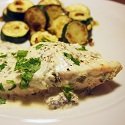 Baked Salmon Fillet
Baked Salmon Fillet |
 The Best Exercises
The Best Exercisesto Lose Weight |
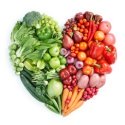 Find the Most
Find the Most Nutritious Fruit |
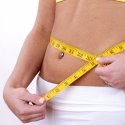 Weight Loss
Weight Loss Tips |
Want To Learn More?
Like This Page?
|
Share This Page:
|
Search Our Site:

Free E-Book:
We Recommend:
Looking to get your body into great shape? Get the very best results for your efforts and money! Save your valuable time from surfing the internet. These are theBestselling Weight Loss Programs
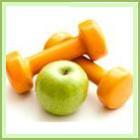
Programs that work and have thousands of satisfied customers worldwide!
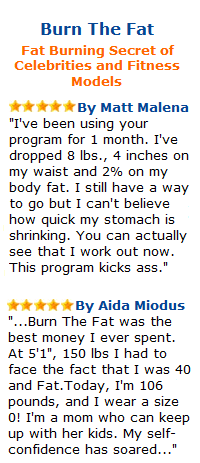
 |
